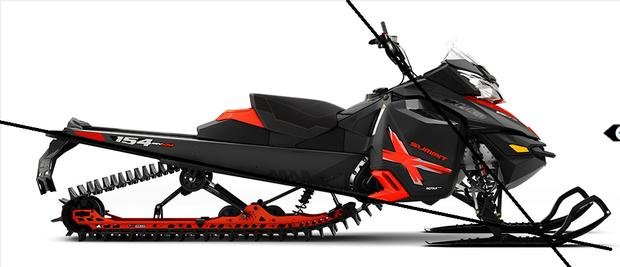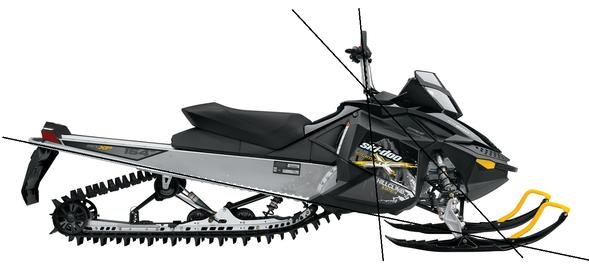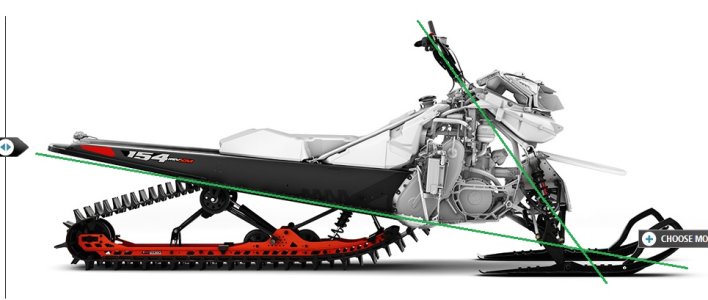You are using an out of date browser. It may not display this or other websites correctly.
You should upgrade or use an alternative browser.
You should upgrade or use an alternative browser.
Mountain Sled Geometry
- Thread starter kidder17
- Start date
maxwell
Active VIP Member
Now don't get to excited Maxy, Like I said in another post, I am very close to snowchecking an XM but the steering post angle throws me off a little.
I always think there are things that could be improved upon, and on the summit I think this is one of them.
Polaris could use an etec of their own and the cat could use a trip to Jenny Craig.
Now correct me if I am wrong, but based on the angle created by your foot stance on the running boards and the angle of the steering post, wouldn't you have less mechanical advantage on the summit than the other two sleds?
I find it ironic that this is something that Ras' himself has always preached, but has recently taken the big back of doo cash and has silently changed the angle of the steering post on his xm. Whats even more ironic is that he hasn't been caught in public riding his xm.
I don't have my steering post like Carl's. can't do it drives me nuts. My riser block is almost straight up and down. Any of my references to steering posts is regarding the way they dip when turned which gives you an advantage in off camber situations. I think you are right in saying you have less mechanical advantage over the sled with the riser in line with the post.
skegpro
Active VIP Member
Agreed, when you push your riser forward like you do I find it really awkward to steer on packed snow.
Last edited:
Like riding a '70s Banana Seat Bike with the bars pushed forwardAgreed, when you push your riser forward like you do I find it really awkward to steer on packed snow.
cdnredneck_t3
Active VIP Member
- Joined
- Feb 17, 2012
- Messages
- 689
- Reaction score
- 1,591
I don't have my steering post like Carl's. can't do it drives me nuts. My riser block is almost straight up and down. Any of my references to steering posts is regarding the way they dip when turned which gives you an advantage in off camber situations. I think you are right in saying you have less mechanical advantage over the sled with the riser in line with the post.
I find the exact opposite. When there is a 20 degree angle from a vertical riser to a angled steering column the bars tend to arc away from you in a counter steer. When the sled starts to wash out and I have to move forward and tip the sled down the hill it really pulls me over the seat and you loose most of your counterweight advantage by getting pulled over the tipping axis. This arc also causes you to do a very un-natural push/pull/twist motion on the bars to turn the skis which is hard on the arms.
The arc is awesome for on the trails though. The bars move to the inside of the turn when turning in the same direction as the turn allowing the rider to get their weight where it needs to be on the inside.
I have an 09 XP by the way and hate the steering geometry.
Now correct me if I am wrong, but based on the angle created by your foot stance on the running boards and the angle of the steering post, wouldn't you have less mechanical advantage on the summit than the other two sleds?
Good photo work. Any chance you are exaggerating the doo's lay-down steering post?
Wrong about the mechanical advantage, though. If anything a perpendicular line between the boards and the steering post axis makes the rider the weakest when turning the bars. For instance, standing on level ground in front of a table, how much force can you push forwards or backwards on it with your feet a normal riding position? The only force you can generate there comes from standing back from the table. Now lift the table instead, you can generate way more force without falling over.
MP Kid
Active VIP Member
That's the biggest load of horse chit I have ever read
Hell of an argument you make there Maxy!
You almost had me up until the point where you claim to be able to read!
LOL. JK!
skegpro
Active VIP Member
Good photo work. Any chance you are exaggerating the doo's lay-down steering post?
Wrong about the mechanical advantage, though. If anything a perpendicular line between the boards and the steering post axis makes the rider the weakest when turning the bars. For instance, standing on level ground in front of a table, how much force can you push forwards or backwards on it with your feet a normal riding position? The only force you can generate there comes from standing back from the table. Now lift the table instead, you can generate way more force without falling over.
Haha, it’s the best I can do with Paint.
I think you and I are saying the same thing. I don't disagree that the angle of the running boards help you to create leverage over the bars. However I believe the closer the steering post angle is to being parallel with your body the easier it is to "roll the sled up".
Attachments
- Thread starter
- #29
What results has anyone had in playing with bar height? On my Pro's I have always switched out the stock Pro Taper bars for the Lower versions available finding that the lower height gets the bars into my "power" zone of arm pull as Rasmussen and Burandt have always preached.
With the XM's I have ridin I again find the bars to be awkwardly tall and wonder if a substantially lower lever would aid in better control and take away some of the effect of that awkward feeling. And by lowering I am talking like 3-4".
With the XM's I have ridin I again find the bars to be awkwardly tall and wonder if a substantially lower lever would aid in better control and take away some of the effect of that awkward feeling. And by lowering I am talking like 3-4".
Last edited:
skegpro
Active VIP Member
skegpro
Active VIP Member
What results has anyone had in playing with bar height? On my Pro's I have always switched out the stock Pro Taper bars for the Lower versions available finding that the lower height gets the bars into my "power" zone of arm pull as Rasmussen and Burandt have always preached.
With the XM's I have ridin I again find the bars to be awkwardly tall and wonder if a substantially lower lever would aid in better control and take away some of the effect of that awkward feeling. And by lowering I am talking like 3-4".
Yeah if I do end up going with the XM I am going to throw that adjustable height riser block on to find out.
Keep in mind that, although I have never seen either IRL, they both come off as about 5'6". It only makes sense that they would like lower bars than average and tall riders.
What results has anyone had in playing with bar height? On my Pro's I have always switched out the stock Pro Taper bars for the Lower versions available finding that the lower height gets the bars into my "power" zone of arm pull as Rasmussen and Burandt have always preached.
With the XM's I have ridin I again find the bars to be awkwardly tall and wonder if a substantially lower lever would aid in better control and take away some of the effect of that awkward feeling. And by lowering I am talking like 3-4".
Lots of guys switching to the SLP Spindles to get a change in the geometry on the Doo. if you can get the sled to sidehill/carve better due to less steering input then the chance of washout is lessened once the sled is "dug in" better.
maxwell
Active VIP Member
All I gotta say is if you cant side hill an XM holly F#ck give up you suck...LMAO
Thank you for putting my thoughts into words.
takethebounce
Active VIP Member
how does that make any sense whatsoever? the steering post postion on the polaris and cat machines are so far back that the rider weight is closer to the rear of the sled therefor causing the sled to wash out easier. mountain riding basics if you want to recover a washout on any machine you move forward. so how on earth does having the rider in a starting position further back create less washout? its pretty clear by comments like this and the photo that its not a matter of any sled "washing out" more than the other but its the rider that needs to adjust there position to controll the level of sidehill washout they desire. i can control my washout on a steep sidehill very acurately. but jump on another sled and you need to adjust your rider position to control this differently. before we get carried away how are these photos taken? are they lined up on a mark on the floor to the spindle location? camera in the same spot? distance kept constant from the machine center point? have reference points been chosen on the sleds and scaled to real life distance measurements? in order for this to be true and correct it would have to me input into autocad and scaled correctly. and by that i mean you could click a distance between any 2 points on either machine and compare it to actual.
I was responding to sledsluts comment that "SKI-DOO has more of an area you can stand on with keeping the sled balanced. meaning ease of ride."
Which I don't feel is entirely true. On the XP/XM you typically need to get as much weight forward to keep it from washing out. But I already said that.
I then said, "On a Poo the distance is smaller between (as is the cat) and the sleds don't tend to wash out and the rider position is more forgiving. What you would think is the opposite but it is not true." This again was in response to sledslut's post that there is more of an area you can stand on with keeping the sled balanced.
This is purely an observation. You want to disagree that the distances are smaller between the two loations that I mentioned? Not only is it in black and white, it is in color. But you want to find an arguement in that observation. Its an observation. Relax.
Did I say that it is the entire reason why one sled is easier to side hill than another? Do we need to go out and add all of this geometry into autocad to prove something? If so, what do you want it to prove?
Your right, the steering post on the cat and polaris are further back, pushing the rider back. Yet, on those sleds, having the rider further back doesn't cause the sled to wash out, which you question as high lighted above. So why is that? Could the shorter distance between the locations be the reason? Maybe not, but I didn't say that was the reason either.
The actual mounting locations, pivot points and so on are only a small portion of the equation. If you recall, the 2011 Freeride, the rear arm was mounted 4" further back than the Summits. It caused the sled to trench much more. It was great for transfer during climbing, but not for pow. So the the further back loation of the Doo rear skid mount does make a difference. What would happen if Doo moved it further ahead? The remainder of the equation is the componets and design of the components in the package. The shocks, springs, how they are mounted, meantto perform and so on.
Remember, 4 degrees of tilt in a skid can with other subtile changes greatly improve a sleds handling characteristics. I have no problem agreeing that the rider must make adjustments to their riding to react to the sled and how you want the sled to ride. Two identical sleds made on the line at the exact same time and handle very different depending on set up. That doesn't change the fact that the XP suffered from the rider not being able to get weight forward. Not every rider had issues with this, but obviously there were shortcomings in the design or they wouldn't have move the post forward in the XM along with cutting out the footwells to allow the rider to position them selves further ahead.
Last edited:
- Thread starter
- #37
This is what I noticed too in the Picture.
I was responding to sledsluts comment that "SKI-DOO has more of an area you can stand on with keeping the sled balanced. meaning ease of ride."
Which I don't feel is entirely true. On the XP/XM you typically need to get as much weight forward to keep it from washing out. But I already said that.
I then said, "On a Poo the distance is smaller between (as is the cat) and the sleds don't tend to wash out and the rider position is more forgiving. What you would think is the opposite but it is not true." This again was in response to sledslut's post that there is more of an area you can stand on with keeping the sled balanced.
This is purely an observation. You want to disagree that the distances are smaller between the two loations that I mentioned? Not only is it in black and white, it is in color. But you want to find an arguement in that observation. Its an observation. Relax.
Did I say that it is the entire reason why one sled is easier to side hill than another? Do we need to go out and add all of this geometry into autocad to prove something? If so, what do you want it to prove?
Your right, the steering post on the cat and polaris are further back, pushing the rider back. Yet, on those sleds, having the rider further back doesn't cause the sled to wash out, which you question as high lighted above. So why is that? Could the shorter distance between the locations be the reason? Maybe not, but I didn't say that was the reason either.
The actual mounting locations, pivot points and so on are only a small portion of the equation. If you recall, the 2011 Freeride, the rear arm was mounted 4" further back than the Summits. It caused the sled to trench much more. It was great for transfer during climbing, but not for pow. So the the further back loation of the Doo rear skid mount does make a difference. What would happen if Doo moved it further ahead? The remainder of the equation is the componets and design of the components in the package. The shocks, springs, how they are mounted, meantto perform and so on.
Remember, 4 degrees of tilt in a skid can with other subtile changes greatly improve a sleds handling characteristics. I have no problem agreeing that the rider must make adjustments to their riding to react to the sled and how you want the sled to ride. Two identical sleds made on the line at the exact same time and handle very different depending on set up. That doesn't change the fact that the XP suffered from the rider not being able to get weight forward. Not every rider had issues with this, but obviously there were shortcomings in the design or they wouldn't have move the post forward in the XM along with cutting out the footwells to allow the rider to position them selves further ahead.
sledneck_03
Active VIP Member
Lots of guys switching to the SLP Spindles to get a change in the geometry on the Doo. if you can get the sled to sidehill/carve better due to less steering input then the chance of washout is lessened once the sled is "dug in" better.
do you have a link to those?
Anyone tired the skinz a arms on the xp or xm?
sledneck_03
Active VIP Member
Haha, it’s the best I can do with Paint.
I think you and I are saying the same thing. I don't disagree that the angle of the running boards help you to create leverage over the bars. However I believe the closer the steering post angle is to being parallel with your body the easier it is to "roll the sled up".
if you make the sled naked its more like this.
Attachments
maxwell
Active VIP Member
do you have a link to those?
Anyone tired the skinz a arms on the xp or xm?
Don't ruin your sled with slp junk spindles
Similar threads
- Replies
- 32
- Views
- 4K






